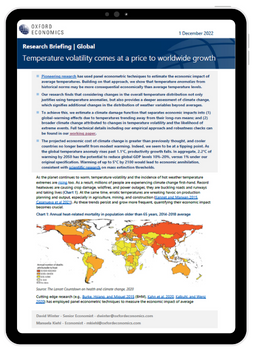Temperature volatility comes at a price to worldwide growth

Pioneering research has used panel econometric techniques to estimate the economic impact of average temperatures. Building on that approach, we show that temperature anomalies from historical norms may be more consequential economically than average temperature levels.
What you will learn:
- Our research finds that considering changes in the overall temperature distribution not only justifies using temperature anomalies, but also provides a deeper assessment of climate change, which signifies additional changes in the distribution of weather variables beyond averages.
- To achieve this, we estimate a climate damage function that separates economic impacts into (1) global-warming effects due to temperatures trending away from their long-run means; and (2) broader climate change attributed to changes in temperature volatility and the likelihood of extreme events. Full technical details including our empirical approach and robustness checks can be found in our working paper.
- The projected economic cost of climate change is greater than previously thought, and cooler countries no longer benefit from modest warming. Indeed, we seem to be at a tipping point. As the global temperature anomaly rises past 1.1°C, productivity growth falls. In aggregate, 2.2°C of warming by 2050 has the potential to reduce global GDP levels 10%-20%, versus 1% under our original specification. Warming of up to 5°C by 2100 would lead to economic annihilation, consistent with scientific research on mass extinction thresholds.
Tags:
Related Services

Service
Country Climate Analysis
Assess the impact climate change will have on all facets of your business. Now and in the future.
Find Out More
Service
Global Risk Service
A suite of data-driven and forward-looking tools that provide an objective and transparent measure of risk.
Find Out More
Service
Global Sustainability Model
Accurately measure your organisation's global footprint through economic, environmental and social lenses, identify risks and develop strategies to become more sustainable.
Find Out More